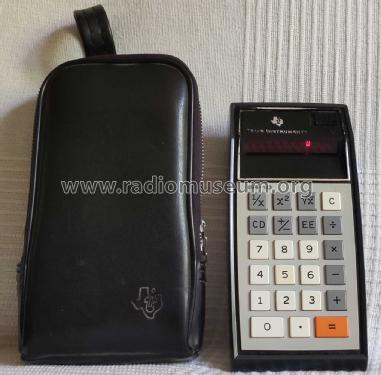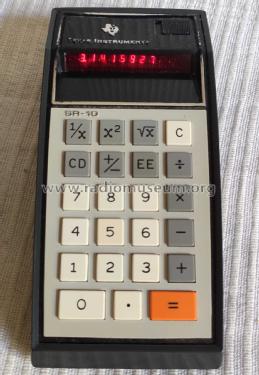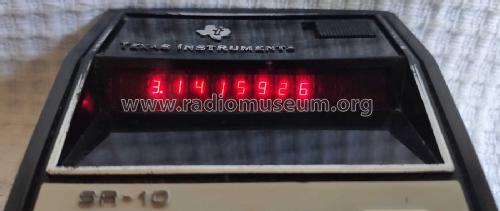SR-10 SR10636358
Texas Instruments, Dallas
- Pays
- Etats-Unis
- Fabricant / Marque
- Texas Instruments, Dallas
- Année
- 1974 ?
- Catégorie
- Processeur de signal et informatique
- Radiomuseum.org ID
- 330320
- Gammes d'ondes
- - sans
- Tension / type courant
- Batteries / Alim. BT séparée avec fiche / AA: 3 x 1.5 Volt
- Haut-parleur
- - - Pas de sortie basse fréquence
- Matière
- Plastique moderne (pas de bakélite, ni de catalin)
- De Radiomuseum.org
- Modèle: SR-10 SR10636358 - Texas Instruments, Dallas
- Forme
- Portable, appareil de poche. Taille < 20cm
- Dimensions (LHP)
- 78 x 158 x 38 mm / 3.1 x 6.2 x 1.5 inch
- Remarques
-
Texas Instruments described the SR-10 as an "electronic slide rule calculator", hence the "SR" in the name.
The SR-10 shown here is the 2nd version of the SR-10 that has the logo on the input keyboard. The SR-10 was manufactured in the USA and Italy.
The SR-10 works with three AA batteries or rechargeable batteries, which can be charged via an external power supply unit. The socket is protected against polarity reversal by a diode.
Unlike the pocket calculators customary at the time, the SR-10 offered an extended arithmetic range (up to 10 ^ 99), as well as a square and square root function. The input takes place normally via algebraic input logic, in which the arithmetic operations are concluded at the end with (IS EQUAL). An incorrect entry can be corrected using the (CD) key.
The zippered leather bag has both a loop and a hook for attaching the calculator to a belt.
The first models cost $149.95 in the US - the second model, which was released in December 1973, was $89.99.
Ende 1972 brachte Texas Instruments den ersten wissenschaftlichen Taschenrechner auf den Markt, der in mehreren Versionen gefertigt wurde.Texas Instruments beschrieb den SR-10 als „elektronischen Rechenschieber“ (“electronic slide rule calculator”), daher das „SR“ im Namen.
Der hier gezeigte SR-10 ist die 2. Version des SR-10 der das Logo auf der Eingabetastatur trägt. Der SR-10 wurde in den USA und in Italien gefertigt.
Der SR-10 arbeitet mit drei AA Batterien oder Akkus, die über ein externes Steckernetzgerät geladen werden können. Die Buchse ist dabei verpolungssicher durch eine Diode gesichert.
Anders als die damals üblichen Taschenrechner bot der SR-10 einen erweiterten Rechenbereich (bis 10^99), sowie eine Quadrat- und Quadratwurzelfunktion. Die Eingabe erfolgt normal per algebraischer Eingabelogik, bei der am Schluß per (ISTGLEICH) die Rechenoperationen abgeschlossen werden. Eine fehlerhafte Eingabe kann über die (CD) Taste korrigiert werden.
Die Ledertasche mit Reißverschluss hat sowohl eine Schlaufe als auch einen Haken zum Befestigen des Taschenrechners an einem Gürtel.
Die ersten Modelle kostete in den USA U$ 149,95- das zweite Modell das Dezember 1973 erschien U$ 89,99-.
- Poids net
- 0.262 kg / 0 lb 9.2 oz (0.577 lb)
- Prix de mise sur le marché
- 89.99 USD
- Auteur
- Modèle crée par Klaus R. Tiefenbacher. Voir les propositions de modification pour les contributeurs supplémentaires.
- D'autres Modèles
-
Vous pourrez trouver sous ce lien 9 modèles d'appareils, 7 avec des images et 4 avec des schémas.
Tous les appareils de Texas Instruments, Dallas
Collections
Le modèle SR-10 fait partie des collections des membres suivants.




